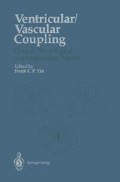Abstract
The character of the arterial pulse as palpated by the physician at the bedside, and laboratory counterpart measurements, such as pulse or pressure recordings, historically have been a critical part of the clinical evaluation of patients with cardiovascular disease. A fine review of the history of the nomenclature and interpretation of the arterial pulse, based on extensive studies of hemodynamics, has recently been provided by O’Rourke (1982).
Access this chapter
Tax calculation will be finalised at checkout
Purchases are for personal use only
Preview
Unable to display preview. Download preview PDF.
Bibliography
Elzinga, G., and Westerhof, N. 1973. Pressure and flow generated by the left ventricle against different impedances. Circ. Res. 32:178–186.
Kouchoukos, N. T., Sheppard, L. C., and McDonald, D. A. 1970. Estimation of stroke volume in the dog by a pulse contour method. Circ. Res. 26:611–623.
Latham, R. D., Westerhof, N., Sipkema, P., Rubal, B. J., Reuderink, P., and Murgo, J. P. 1985 1986. Regional wave travel and reflections along the human aorta: a study with simultaneous micromanometry. Circulation, 72:1257–1269.
McDonald, D. A. 1974. Blood Flow in Arteries. 2nd Ed. London: Arnold.
McDonald, D. A., and Taylor, M. G. 1956. An investigation of the arterial system using a hydraulic oscillator. J. Physiol. (Lond.) 133:74–75.
Milnor, W. R. 1982. Hemodynamics. Baltimore: Williams & Wilkins.
Murgo, J. P., Altobelli, S. A., Dorethy, J. F., Logsdon, J. R., and McGranahan, G. M. 1975. Normal ventricular ejection dynamics in man during rest and exercise. In Leon, D. F., and Shaver, J. A., eds. Physiologic Principles of Heart Sounds and Murmurs. Dallas: American Heart Association, Monograph 46, pp. 92–101.
Murgo, J. P., Giolma, J. P., and Altobelli, S. A. 1977. Signal acquisition and processing for human hemodynamic research. Proc. IEEE 65:696–702.
Murgo, J. P., and Westerhof, N. 1984. Input impedance of the pulmonary arterial system in normal man. Circ. Res. 54:666–673.
Murgo, J. P., Westerhof, N., Giolma, J. P., and Altobelli, S. A. 1980. Aortic input impedance in normal man: relationship to pressure wave forms. Circulation 62:105–116.
Murgo, J. P., Westerhof, N., Giolma, J. P., and Altobelli, S. A. 1981a. Manipulation of ascending aortic pressure and flow wave reflections with the Valsalva maneuver: relationship to input impedance. Circulation 63:122–132.
Murgo, J. P., Westerhof, N., Giolma, J. P., and Altobelli, S. A. 1981b. Effects of exercise on aortic input impedance and pressure waveforms in normal humans. Circ. Res. 48:334–343.
O’Rourke, M. F. 1971. The arterial pulse in health and disease. Am. Heart J. 82:687–702.
O’Rourke, M. F. 1982. Arterial Function in Health and Disease. Edinburgh/London: Churchill Livingstone.
Van den Bos, G. C., Westerhof, N., and Randall, O. S. 1982. Pulse wave reflection: can it explain the differences between systemic and pulmonary pressure and flow waves? Circ. Res. 51:479–485.
Westerhof, N., Elzinga, G., and Van den Bos, G. C. 1973. Influence of central and peripheral changes on the hydraulic input impedance of the systemic arterial tree. Med. Biol. Eng. 11:710–723.
Westerhof, N., Murgo, J. P., Sipkema, P., Giolma, J. P., and Elzinga, G. 1979. Arterial Impedance. In Hwang, N. H. C., Gross, D. R., and Patel, D. J., eds. Quantitative Cardiovascular Studies. Baltimore: University Park Press, pp. 110–131.
Westerhof, N., Sipkema, P., Van den Bos, G. C., and Elzinga, G. 1972. Forward and backward waves in the arterial system. Cardiovasc. Res. 6:648–656.
Wetterer, E. 1954. Flow and pressure in the arterial system, their hemodynamic relationship and the principles of their measurement. Minn. Med. 37:77–86.
Editor information
Editors and Affiliations
Rights and permissions
Copyright information
© 1987 Springer-Verlag New York Inc.
About this chapter
Cite this chapter
Murgo, J.P., Westerhof, N. (1987). Arterial Reflections and Pressure Waveforms in Humans. In: Yin, F.C.P. (eds) Ventricular/Vascular Coupling. Springer, New York, NY. https://doi.org/10.1007/978-1-4613-8634-6_6
Download citation
DOI: https://doi.org/10.1007/978-1-4613-8634-6_6
Publisher Name: Springer, New York, NY
Print ISBN: 978-1-4613-8636-0
Online ISBN: 978-1-4613-8634-6
eBook Packages: Springer Book Archive

